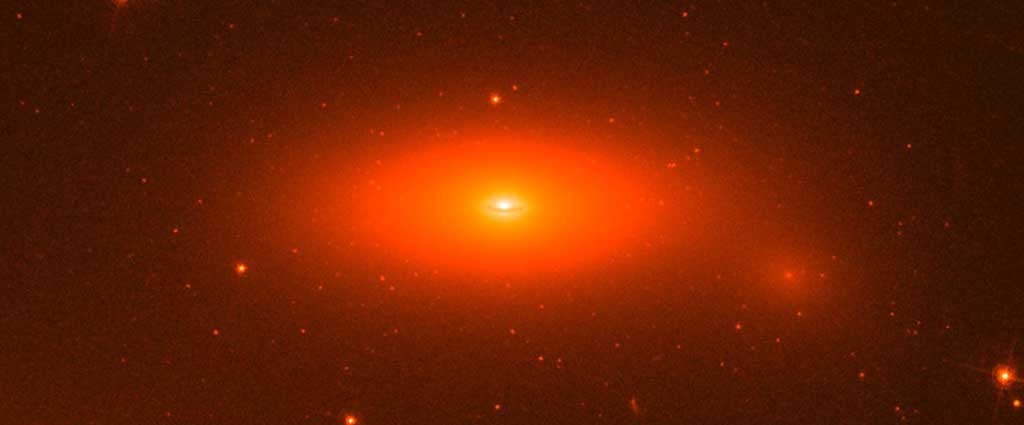To the best of our astronomical knowledge, almost every galaxy should contain in its central region what is called a supermassive black hole — a black hole with a mass between that of hundreds of thousands and billions of Suns. The best-studied supermassive black hole sits in the center of the Milky Way Galaxy with a mass of about 4 million Suns.
For the masses of galaxies and their central black holes, an intriguing trend has emerged — a direct relationship between the mass of a galaxy’s black hole and that of the galaxy’s stars.
Typically, the black hole mass is a tiny fraction of the galaxy’s total mass. But now a search led by van den Bosch has discovered a massive black hole that could upset the accepted relationship between black hole mass and galaxy mass, which plays a key role in all current theories of galaxy evolution. The observations used the Hobby-Eberly Telescope and existing images from the Hubble Space Telescope.
With a mass 17 billion times that of the Sun, the newly discovered black hole in the center of the disk galaxy NGC 1277 might even be the biggest known black hole of all. The mass of the current record holder is estimated to lie between 6 and 37 billion solar masses; if the true value lies toward the lower end of that range, NGC 1277 breaks the record. At the least, NGC 1277 harbors the second- biggest known black hole.
The big surprise is that the black hole mass for NGC 1277 amounts to 14 percent of the total galaxy mass, instead of usual values around 0.1 percent. This beats the old record by more than a factor of 10. Astronomers would have expected a black hole of this size inside elliptical galaxies 10 times larger. Instead, this black hole sits inside a fairly small disk galaxy.
Is this surprisingly massive black hole a freak accident? Preliminary analysis of additional data suggests otherwise. So far, the search has uncovered five additional galaxies that are comparatively small yet, going by first estimates, seemed to harbor unusually large black holes, too. More definite conclusions have to await detailed images of these galaxies.
If the additional candidates are confirmed and there are indeed more black holes like this, astronomers will need to rethink fundamentally their models of galaxy evolution. In particular, they will need to look at the early universe. The galaxy hosting the new black hole appears to have formed more than 8 billion years ago and does not appear to have changed much since then. Whatever created this giant black hole must have happened a long time ago.
To the best of our astronomical knowledge, almost every galaxy should contain in its central region what is called a supermassive black hole — a black hole with a mass between that of hundreds of thousands and billions of Suns. The best-studied supermassive black hole sits in the center of the Milky Way Galaxy with a mass of about 4 million Suns.
For the masses of galaxies and their central black holes, an intriguing trend has emerged — a direct relationship between the mass of a galaxy’s black hole and that of the galaxy’s stars.
Typically, the black hole mass is a tiny fraction of the galaxy’s total mass. But now a search led by van den Bosch has discovered a massive black hole that could upset the accepted relationship between black hole mass and galaxy mass, which plays a key role in all current theories of galaxy evolution. The observations used the Hobby-Eberly Telescope and existing images from the Hubble Space Telescope.
With a mass 17 billion times that of the Sun, the newly discovered black hole in the center of the disk galaxy NGC 1277 might even be the biggest known black hole of all. The mass of the current record holder is estimated to lie between 6 and 37 billion solar masses; if the true value lies toward the lower end of that range, NGC 1277 breaks the record. At the least, NGC 1277 harbors the second- biggest known black hole.
The big surprise is that the black hole mass for NGC 1277 amounts to 14 percent of the total galaxy mass, instead of usual values around 0.1 percent. This beats the old record by more than a factor of 10. Astronomers would have expected a black hole of this size inside elliptical galaxies 10 times larger. Instead, this black hole sits inside a fairly small disk galaxy.
Is this surprisingly massive black hole a freak accident? Preliminary analysis of additional data suggests otherwise. So far, the search has uncovered five additional galaxies that are comparatively small yet, going by first estimates, seemed to harbor unusually large black holes, too. More definite conclusions have to await detailed images of these galaxies.
If the additional candidates are confirmed and there are indeed more black holes like this, astronomers will need to rethink fundamentally their models of galaxy evolution. In particular, they will need to look at the early universe. The galaxy hosting the new black hole appears to have formed more than 8 billion years ago and does not appear to have changed much since then. Whatever created this giant black hole must have happened a long time ago.










